In a previous blog, I broke down exactly how rare your personality type is by gender. I also did another blog on numbers of geniuses by personality type. For the purpose of this blog, I am assuming the statistics were based on gender at birth, not self-identified gender. (I suspect certain types are more likely to consider themselves transgendered because of their personality traits, such as female ESTJs, who value traditional societal roles, but see “masculine” traits in themselves.)
Perhaps you have joined a social media group for a bundle of personality types (e.g., NF Idealists, Socionics Gamma Quadra, etc.) and are curious how large of a percentage your type constitutes within that group.
Or, perhaps, you are thinking about joining Mensa or another high-IQ group and curious what your odds are of finding like-minded individuals with whom to exchange and share ideas. (Mensa is well-known for its rule about identifying huggers and non-huggers by nametag.) I’ve also broken down the statistics by MBTI group, gender, and Socionics Quadra (the last will be most likely to think on the same wavelength that you do).
Without further ado, here are the charts:
Exactly How Special is Your Snowflake?

You might remember this chart breaking down type rarity by gender (sorry for the pink and blue – it was the easiest way to distinguish everyone) and the subsequent list from the other blog:
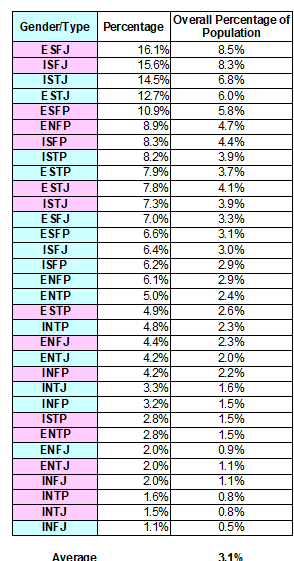
Your type might not be nearly as unique as you thought, now that you see it compared to all the other types. A typical MBTI type by gender constitutes 3.1% of the entire population. With female ESFJs constituting 8.5% of the population, and male INFJs constituting 0.5% of the population, the numbers aren’t as different as a lot of people think.
So You’ve Joined a Few Groups Online…
Most of the MBTI cluster groups on social media are grouped by Jungian groups. The ones I’ve seen tend to have a lot of fighting because half the members seem to think on a different wavelength from the other half. There are real reasons for this. Although Jungian typology divides types up by whether people are “thinkers” or “feelers” and “intuitives” or “sensors”, someone who uses the same cognitive functions you do as their primary functions might actually have letters that are the complete opposite. Socionics is a Russian offshoot of Jungian (and Freudian) psychology that divides the groups up by the four main cognitive functions they use.
The Four Jungian Type-Groups Are:
- SJ – The Guardians (xSxJ)
- SP – The Artisans (xSxP)
- NF – The Idealists (xNFx)
- NT – The Rationals (xNTx)
The problem with this system is that it is really quite random. I could just as easily come up with a grouping of like-minded individuals based on other letters, like:
PsychoBabble4U’s Type-Groups:
- The Leaders (ExxJ)
- The Charmers (ExxP)
- The Revolutionaries (IxxJ)
- The Artists (IxxP)
Does it mean anything? Not really. A friend of mine attempted to start a group for ExxJ types on Facebook and it basically went nowhere.
Nonetheless, most people do identify by their Jungian Type-Group. So this is how rare your type is within your type-group:
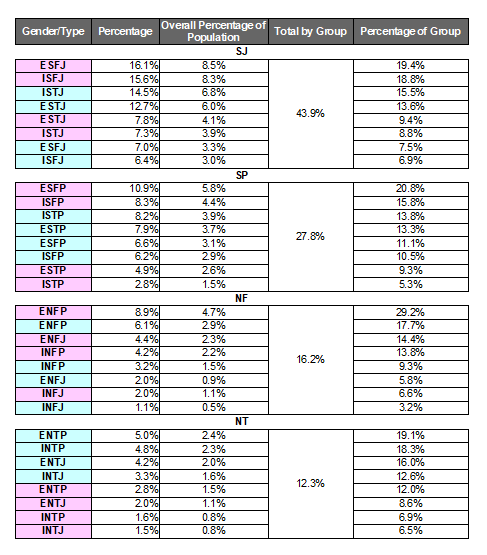
So let’s say you are a female ENFJ and joined an Idealist group on Facebook. The amount of people who really think like you is 14.4%, and males with a similar mindset constitute another 5.8% of the group. (I used ENFJ as an example because there is a marked difference in behavior between male and female.) When you throw in Enneagrams (which are actually pretty consistently 2 among ENFJs, but humor me on this), it becomes more complicated, and then matters of intelligence also figure into this.
The reality is that sparks are likely to fly in such groups, because one half of the group uses one set of cognitive functions, and the other half uses a completely different set. An ENTP (who uses Ne-Ti-Fe-Si) is likely to have ferocious arguments with an ENTJ (who uses Te-Ni-Se-Fi). The 31% of this theoretical group who are ENTPs are also Fe-users, and likely to begin trolling as a pack against the 25% who are ENTJs, or just abandoning the group in disgust. (Reality has shown the latter situation to occur.) This could become even worse among highly emotional NF groups.
Socionics divides the categories up by Cognitive Functions:
- Alpha (Ne, Fe, Ti, Si)
- Beta (Fe, Se, Ti, Ni)
- Gamma (Te, Se, Fi, Ni)
- Delta (Te, Ne, Si, Fi)
In a theoretical Delta Quadra group, all the members value action-oriented logic (Te) and brainstorming about possibilities (Ne). They might place different emphasis on these functions, but everyone would still use them. All Alpha Quadra types value introverted thinking (Ti), traditional societal norms (Si), and group harmony (Fe). In short, everyone within each Quadra thinks on the same wavelength.
Still, within each Quadra, certain types are more common than others. A shy, bookish female INTP would be one of only 2.8% of the group, whereas her outgoing ESFJ counterparts constitute 28.4% of the group.
Here is the breakdown by Quadra:
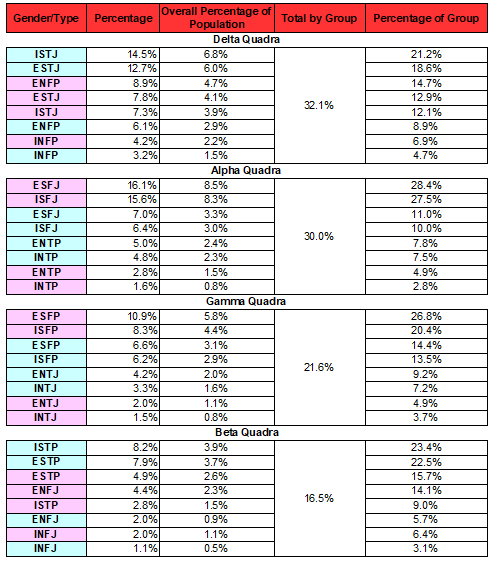
Intelligence Deviations within Type
So you have decided to give up and stick to a group dedicated solely to your own MBTI type and gender? There will still be conflict, because… some people are just smarter than others and some… aren’t. You might be a female INTJ, but there will still be a variety of group members – some might want to discuss the differences between the writings of Kierkegaard and Foucault, and others might just want to talk about their pet cats and desire for alone time to read romance novels.
Contrary to the stereotypes, not all INTx individuals are smart. Although an INTP is 1.76 times more likely to be a genius than a person chosen from a random sample of the population, 96.48% of INTPs are not geniuses. In fact, statistically, about 48.24% of INTPs should have an IQ below 100. (That actual number might vary.)

An average Intelligence Quotient (IQ), by definition, means that half of the population falls below that number. Of course, most people do fall within the 85-115 range in intelligence.
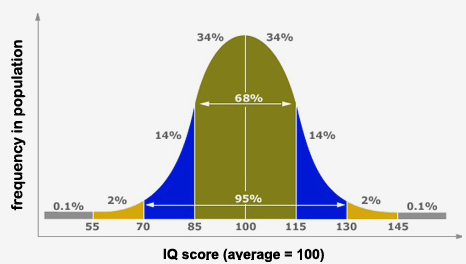
Here is a nice pictorial version of that graph:
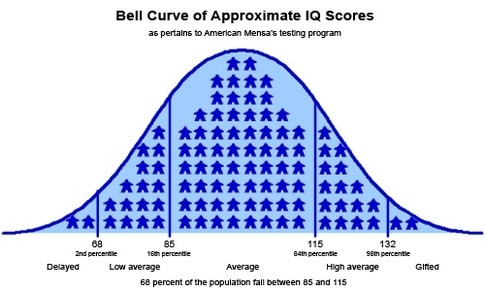
Since people who read blogs and who research online tend to be more intelligent than average by nature, let’s assume you were tested as a child (or as an adult) and are among the top 2% in intelligence in the population and qualify for membership in Mensa or another high IQ society.
First of all, what are your odds of finding someone with the exact same personality type who likes to discuss the deep topics that fascinate you? Although there is slight deviation by personality type, it is not significant:

An INTP is 1.76 times as likely to have an IQ in the top 2% of the population, whereas an ESFJ is one eighth of a percent as likely to have an IQ in the top 2%. Everyone falls somewhere in this range. High IQ (at least two Standard Deviations above the norm, i.e., 130+) is neither excessively high for INTPs, nor is it non-existent among ESFJs.
So your odds of chatting with another genius in your ISFJ Guys group is 0.4%, or 2.76% in your INFJ Females group. Surprisingly, although your personality type might be common, you might not be. The percentages range from 0.014% (INFJ males) to 0.099% (ENFP females) among the general population. Although 8.5% of the entire population are female ESFJs, female ESFJs with high IQs (130+) constitute only 0.02% of the general population. Male INTPs are only 2.3% of the population, but high-IQ INTP males constitute 0.08% of the population at large. In a group of 10,000 people, every type and gender sub-type is represented. In a theoretical school of 20,000 students, there will be 20 ENFP females, and three INFJ males in the gifted program, and each type and sub-type falls somewhere in that range.
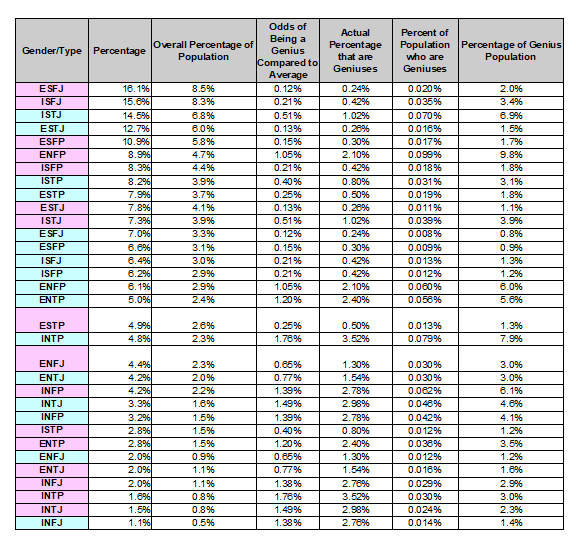
Your odds of meeting someone just like you in a medium-sized high school with 2500 students were quite slim, even if you shared gifted and Advanced Placement classes.
So let’s say you still feel really isolated and decide to join Mensa, which requires an IQ in the top 2% of the population (130+). What are your odds of meeting someone just like you at one of their get-togethers? (This also helps to explain why Mensa has the Hugs/No-Hugs rule.)
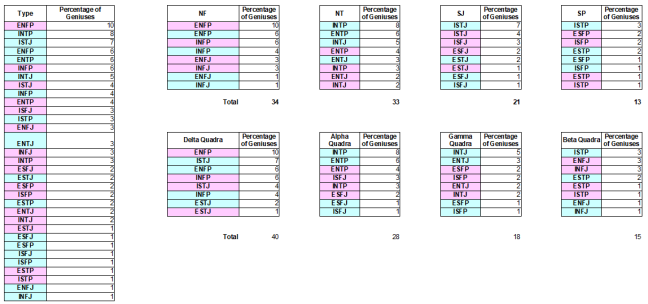
In this theoretical Mensa meeting, one hundred people have shown up. You arrive at the door to sign in, and…
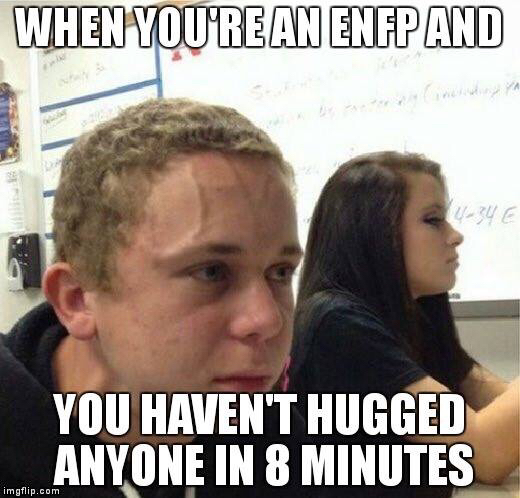
However…
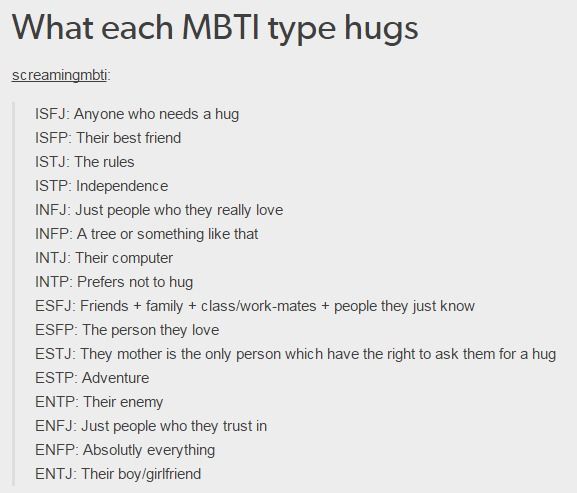
So you declare whether you’re on Team ENFP or Team INTP on the hugging issue.
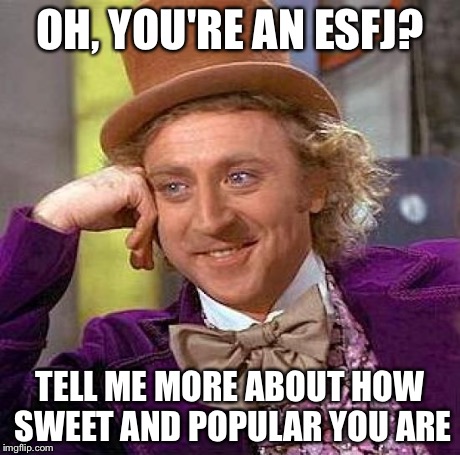
If you want to discuss your high school glory days, you might find a small audience for your friendly small talk.
Time for some deep discussions. You seek out the other people in your MBTI Type-Group, who understand the unique issues related to being an Artisan or a Rational. In that room, you will meet:
- 34 Idealists
- 33 Rationals
- 21 Guardians
- 13 Artisans
If you are one of the 33 Rationals, you might soon find your INTJ nerves grated from listening to one of the ten ENTPs in the room, even though you’re both Intuitive Thinkers. Finally, you gravitate to a group of 18 Gamma Quadra types who share your appreciation for art, writing and creativity and your dark sense of humor. The amount of people you will have a pleasant conversation with in this theoretical Mensa meeting are:
- 40 people if you are a Delta Quadra type (ENFP, ISTJ, INFP, ESTJ)
- 28 people if you are in Alpha Quadra (INTP, ENTP, ISFJ, ESFJ)
- 18 people if you are in Gamma Quadra (INTJ, ENTJ, ISFP, ESFP)
- 15 people if you are in Beta Quadra (ISTP, ENFJ, INFJ, ESTP)
The full breakdowns by type and gender are in the last cluster of charts.